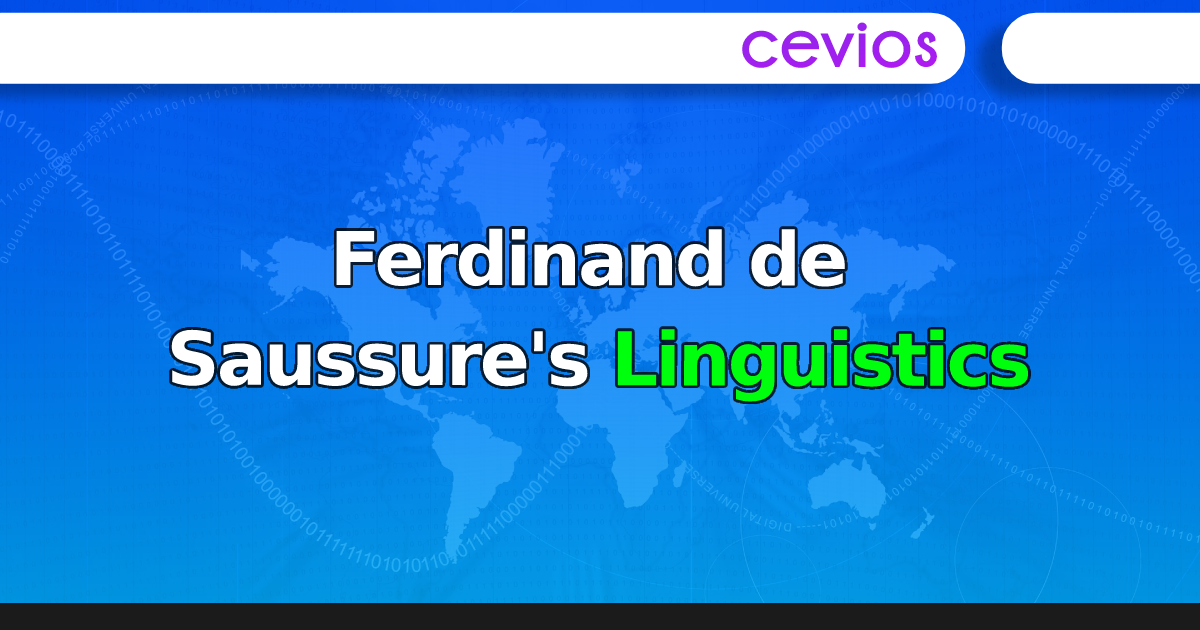Ferdinand de Saussure’s Linguistics
Founding Distinctions of Linguistics
1. Langue and Parole
Langue (language) is a system of signs that is abstract and shared by society. And like any system, it is a code.
Parole (Speech) is the individual exploitation of this latter. It is, therefore, concrete and individual.
To understand the relationship between Langue and Parole, simply imagine Langue as a shared dictionary. Given individual differences, its exploitation by individuals varies.

Note:
– Structural linguistics is a linguistic of la langue.
– Parole is not part of this project.
2. Syntagmatic and Paradigmatic Axes
Since language is linear, the syntagmatic axis (Combination axis) represents the combination of signs horizontally contiguous: It, therefore, involves sequences of elements. Ex: Sign+Sign+Sign; S+V+O….
The paradigmatic axis (Selection axis) concerns invisible signs that can replace present signs on the syntagmatic axis, as in the case of synonyms and antonyms…etc. Ex: courageous/brave/heroic….

Laws Governing the Relations Between Signs
The task of the linguist is to discover the laws governing the relations between signs on the two axes through manipulations such as commutation, permutation, substitution, and omission…etc. And this is done at different linguistic levels.
Linguistic Levels
In the following lines, we are going to hierarchize language levels according to the treated unit, from the smallest to the largest one.
Phonological Level
The basic unit of phonology is the phoneme. Among the objectives of linguists at this level are to understand how phonemes are organized in languages by identifying the laws that govern their relationships[1].
Morphological Level
The morphological unit is morpheme (Moneme in the terminology of André Martinet), morphology studies affixes, flexion, derivation, etc.
Syntactic Level
Syntax studies the combination of words without regard to meaning. A made-up sentence like that of the American linguist Noam Chomsky (to distinguish the syntactic from the semantic), « Colorless green ideas sleep furiously » is semantically wrong and syntactically true.
Semantic Level
In general, the semantic level studies the literal meaning of each unit and that of their combinations. The literal meaning is found in dictionaries; it is often confronted with contextual meaning, a product of usage.
Summary:
– Linguists can discover laws governing a system of signs by manipulating its units on the two axes, syntagmatic and paradigmatic.
– The work is realized at different levels.
3. Synchrony and Diachrony
Synchrony represents the study of the state of a language at a given moment in history.
Diachrony is the study of the evolution of language across history.
Structural linguistics is synchronic.
The Principe of Immanence
The principle of immanence means the study of the internal organization of language in isolation of anything that is extralinguistic[2]: That is, the study of language in-itself and for-itself.

A Closed System
The Limits of Structural Linguistics
Logically speaking, a project that confines itself to a unit such as a sentence, will unavoidably reach saturation[3]. And like any science — as we can learn from the American epistemologist Thomas Kuhn — its evolution will culminate in a crisis[4].
The crisis of structural linguistics was real: with its principle of immanence, it could not explain language phenomena outside of the language system, whether they are psychological, sociological, philosophical, or otherwise.
To meet this need, post-structural linguistics has opened up to other sciences such as psychology, sociology, anthropology, neurosciences…, etc.
Nevertheless, we should admit the genius idea of structuralism and highlight that its limits do not necessarily mean its falsity. (Charaudeau, Langage et discours, p.3)
[1] Cf. (Siouffi and Van Raemdonck, 100 fiches pour comprendre la linguistique, p.41)
[2] Extralinguistic refers to anything outside of the linguistic such as context and all that is psychological, sociological, etc.
[3] In general, saturation is used to describe a research state in which newly explored information does not bring novelties.
[4] The physicist and epistemologist Thomas Kuhn observed how science evolves and summed it up in a cycle that is similar to that of the seasons. According to this theory, science does not evolve linearly — in which simple knowledge accumulates — Science evolves in a circular way, revolving around a paradigm. Each time it falls into a crisis, it should be changed (Paradigm Shift). Cf. (Khettab, Sid Ahmed. “The Evolution of Science: The Kuhn Cycle,” 2020. https://doi.org/10.13140/RG.2.2.13398.06727).
“Ferdinand de Saussure’s Linguistics” is part of:
Khettab, Sid Ahmed. Semiotics and Semiology: From Sign to Semiosis and From Code to Discourse [Course]. 2021. DOI.org (Datacite), https://doi.org/10.13140/RG.2.2.23509.55520. [Online Article]
KHETTAB, Sid Ahmed. Semiotics and Semiology: From Sign to Semiosis and From Code to Discourse. Independently published, 2021, https://www.amazon.com/Semiotics-Semiology-Sign-Semiosis-Discourse/dp/B0959N6111. [Paperback]

